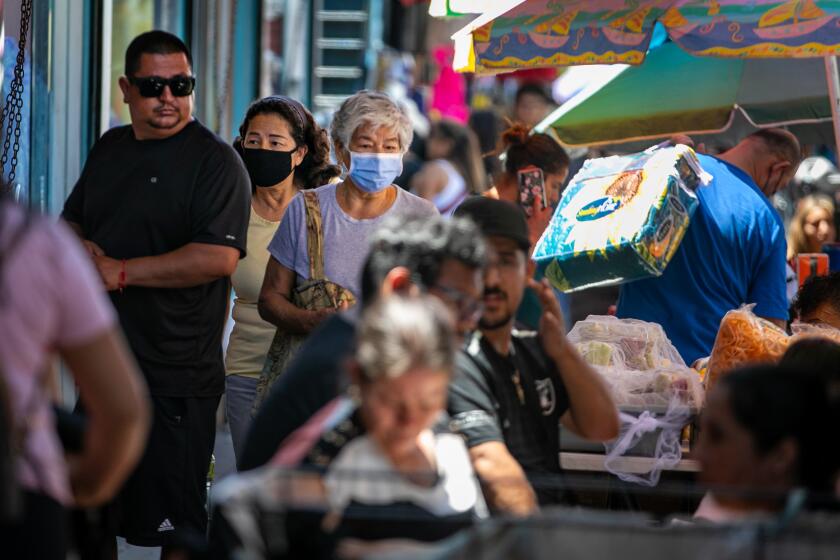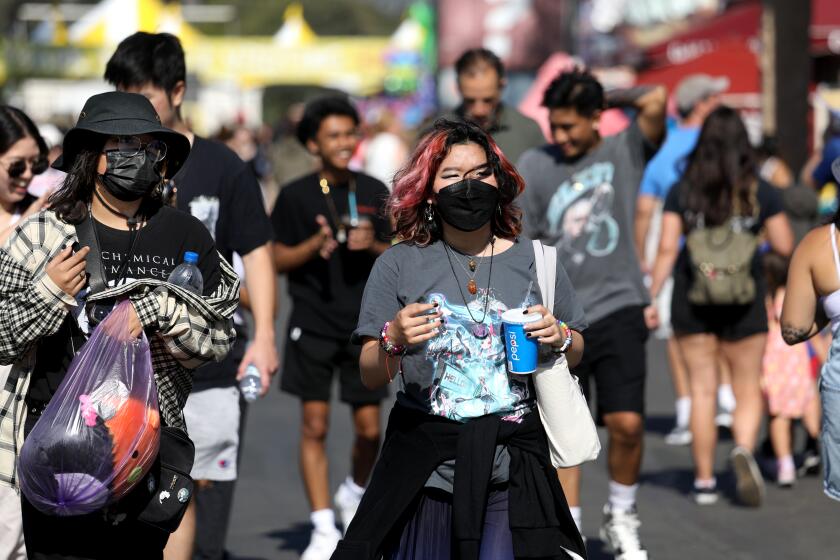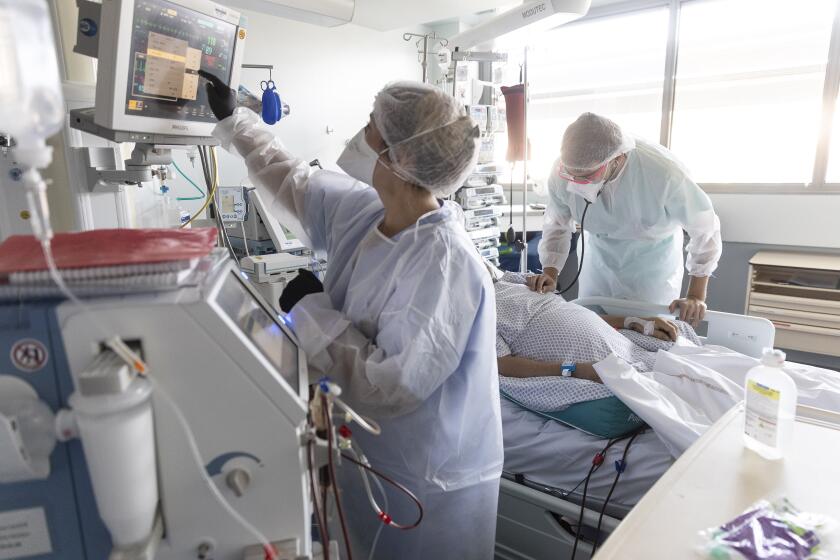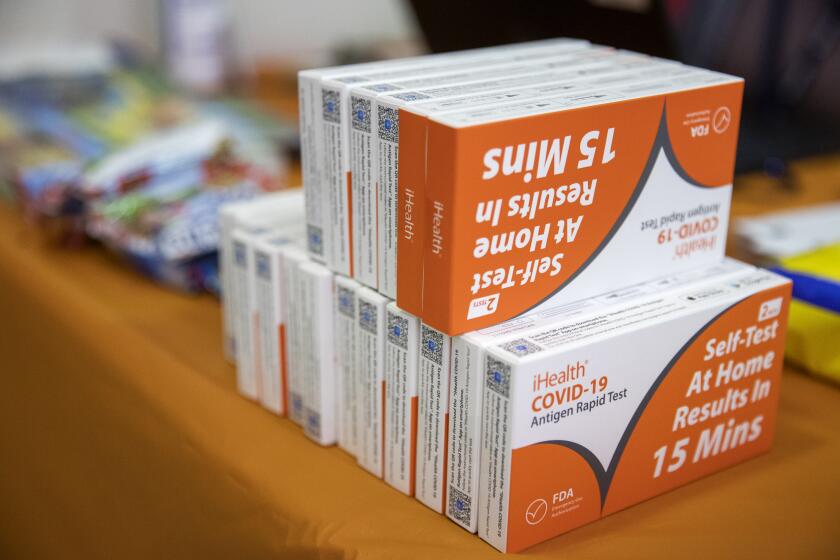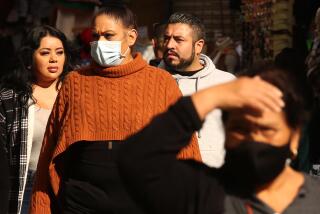Indoor mask rules expected next week as L.A. coronavirus wave worsens
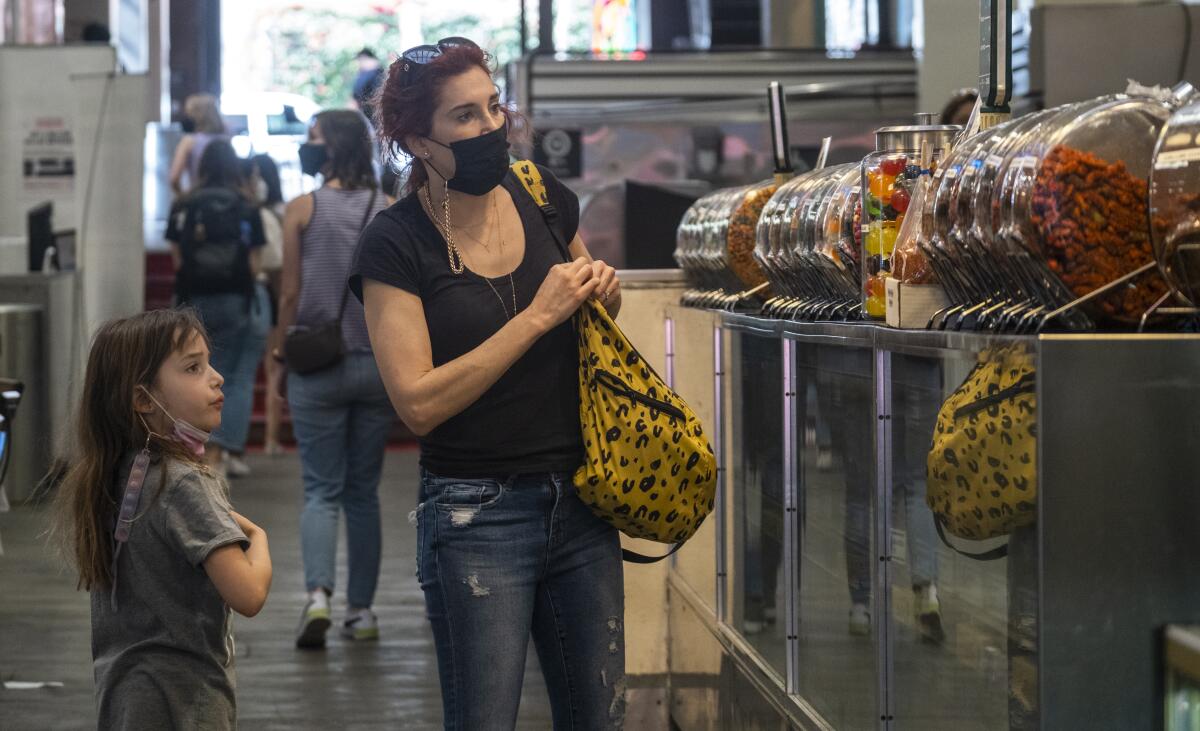
- Share via
Los Angeles County is poised to impose new indoor mask rules next week as data show the hyper-infectious BA.5 Omicron subvariant is pushing coronavirus case counts higher and sending increasing numbers of people to the hospital.
A new mask mandate would mark a significant escalation in the response to the new subvariants, which have fueled a spring-and-summer surge and can cause people to quickly be reinfected with the coronavirus. L.A. County would be the first county in Southern California to bring back masks this year, and it remains unclear whether other areas would join. Alameda County issued a mask mandate June 3 and rescinded it three weeks later.
Although a final decision is still days away, the likelihood of a mask rule has sparked growing debate in a society weary of both the pandemic and its restrictions.
Proponents say the move is an effective and low-impact way to help stymie soaring coronavirus transmission. L.A. County — the nation’s most populous — is like no other county in California. With its higher rate of poverty and overcrowded housing, it has been hit harder than most parts of the state.
“Of all the tools we have used in this pandemic to counter the spread of COVID, indoor masking is one of the simplest, and turns out to be very effective,” county Public Health Director Barbara Ferrer said Thursday.
Still, critics are questioning the need. Hospitals and intensive care units are nowhere near as strained as during the peaks of previous surges and, thanks in part to vaccinations and anti-COVID drugs, the relative overall risk of severe illness is far less than it was a year or two ago.
Coronavirus cases are rising in California because of super-infectious Omicron subvariants BA.4 and BA.5. But the public is not on high alert.
Some business groups have also voiced concerns that the mask order could prompt shoppers to take their money elsewhere, or that workers will have to enforce rules many no longer want to follow.
A renewed mandate would apply indoors for anyone age 2 or older at a host of establishments and venues, including shared office space, manufacturing and retail settings, event spaces, restaurants and bars, gyms and yoga studios, educational settings and children’s programs.
L.A. County officials long ago set the criteria for this health order revision — saying they would reissue a mask mandate should the region move into the “high” COVID-19 community level, as defined by the U.S. Centers for Disease Control and Prevention, and remain there for two consecutive weeks.
To be in that category, a county must record elevated levels of coronavirus spread as well as at least 10 new weekly coronavirus-positive hospitalizations for every 100,000 residents. L.A. County exceeded that threshold last week and did so again Thursday, recording 11.4 weekly hospitalizations for every 100,000 people. The rate was 10.5 a week ago.
Unless the hospitalization rate drops below 10 next week, a new mask order would go into effect July 29.
The latest maps and charts on the spread of COVID-19 in Los Angeles County, including cases, deaths, closures and restrictions.
Ferrer said she hopes L.A. County doesn’t get to that point and that any mandate is short-lived. If issued, a masking order would be lifted when the county exits the high community level and stays out of that category for two consecutive weeks.
“It isn’t going to take much to move us back into that ‘medium’ community level if we can get our case numbers to go lower,” she said.
In a new development, Ferrer said Thursday that the county could hold off on a mandate if transmission shows pronounced signs of slowing — as tumbling case counts will lead to corresponding decreases in hospitalizations a week or two later.
“Should we start seeing a steep decline in our [case] numbers next week — because we know that hospitalizations are this lagging indicator — we are likely to want to take a pause on moving too quickly on universal indoor masking,” she said.
The likelihood of that scenario is unclear, however. L.A. County on Thursday reported nearly 8,700 new cases — one of the highest single-day totals of the current wave.
Many who become infected are not falling seriously ill. While hospitalizations are rising, patients are generally less sick, and intensive care units are less crowded than in previous surges.
Countywide, 1,329 coronavirus-positive patients were hospitalized as of Wednesday — a 34% increase from two weeks ago.
By comparison, the statewide patient count has climbed 23% over that period, to 4,762.
In both L.A. County and California as a whole, hospitalizations remain well below those during prior peaks. And officials note a significant share of those patients — about 57% in L.A. County — are not receiving treatment for COVID-19 but incidentally tested positive on admission for other reasons.
However, a vast majority of coronavirus-positive people in intensive care units — about 71% — are being treated for COVID-19, Ferrer said.
As of Thursday, L.A. County was reporting 6,753 coronavirus cases a day for the past week, up 5% from the prior week and nearly double the peak from last summer’s Delta surge. However, this increase was notably flatter than a week ago, when there was a 25% jump.
On a per capita basis, L.A. County is recording 468 cases a week for every 100,000 residents. A rate of 100 or more is considered high.
That the patient count, while rising, has remained relatively low in the face of high transmission is a testament to how the pandemic has changed.
The order, which could go into effect as soon as July 29, has raised concerns among business groups and sparked questions about its necessity.
Most of those getting infected now are not falling seriously ill, a trend that officials and experts credit to robust vaccine coverage and ready availability of treatments.
Some have pointed to this disconnect as evidence against imposing a new mask mandate. If hospitals aren’t anywhere close to being overwhelmed, what’s the justification?
“We’re in a much better place, and people should enjoy their lives,” Ferrer said. But there are a number of worrisome signs about the latest surge that would warrant a mask requirement next week unless conditions improve, she said.
The percent of emergency room visits related to COVID-19 has doubled since Memorial Day, from 5% to 10%. Worksites are seeing major disruptions, and some are short on staffing. L.A. County reported 429 worksites with clusters of coronavirus cases per week, more than double from the start of June. There were 33 nursing homes in the last week with newly reported outbreaks, a figure that has doubled over the same period.
“High community transmission also leads to preventable and avoidable deaths, primarily among those most vulnerable,” Ferrer said. “If we can slow down transmission, we have a good chance of preventing some people from dying in the upcoming months.”
COVID-19 deaths remain elevated. L.A. County has been reporting 86 to 100 deaths a week, up from about 50 a week.
A new study offers insight into the prevalence of long COVID and suggests who might be more likely to develop the condition.
Some may be confident they won’t be seriously harmed when getting COVID-19, but there is still uncertainty around who will experience a serious illness. Some patterns are still holding: Hospitalization rates have grown much faster in recent weeks for older residents.
“When people pass along misinformation that the current COVID surge is not affecting or hurting anyone, these are the people they are dismissing: our elders,” Ferrer said.
It’s also important to reduce the number of people who could otherwise develop long COVID, she said, in which symptoms of fatigue, brain fog and difficulty breathing can persist for months or years and can be so debilitating that people can no longer work.
Reinfections also add risk: One study of mostly white veterans, who were on average in their early 60s — who were infected with the coronavirus more than once — had a two times higher risk of death and 2½ times higher risk of developing heart or lung disease or problems with blood vessels and blood clotting, compared to those who were infected once.
And a high level of coronavirus transmission only increases the risk of new mutations that could cause more harm.
“It’s very attractive to minimize what in fact is happening now … and I think that’s a mistake,” Ferrer said. She said requiring masks when hospitalization rates rise is a “nice middle ground.”
“I know people are sort of saying, putting masks on is really asking a lot of folks. We asked a lot more of everybody — for a much longer time — for much of the past two years,” Ferrer said.
Some critics don’t see the justification.
“For two years straight, Californians wore masks inside. They got vaccinated at high rates. Many got boosted. The rates of severe disease are so decoupled from hospitalizations, and that’s so obvious to the public,” said Dr. Monica Gandhi, an infectious-disease expert at UC San Francisco.
That’s been the experience at the Los Angeles County-USC Medical Center, the largest of four county-run public hospitals. During an internal town hall last week that was posted online, Chief Medical Officer Dr. Brad Spellberg said about 90% of the hospital’s coronavirus-positive patients were admitted for other issues and “virtually none of them go to the ICU.”
The number of COVID-19 deaths in the last 6 ½ months in L.A. County — nearly 4,500 — far exceeds the death toll the county typically saw from the flu in an entire pre-pandemic year, about 1,500.
The CDC recommends public indoor masking for counties in the “high” community level. As of Thursday, that included 50 of California’s 58 counties, home to a combined 38.6 million people. Riverside and San Bernardino counties entered the high COVID-19 community level Thursday for the first time since spring.
But L.A. County stands alone in pursuing a renewed mask order. When asked about differing approaches, Ferrer pointed to factors that have left L.A. particularly vulnerable, including its size and population of 10 million, 2 million of whom remain unvaccinated.
The county is also home to many older residents generally at higher risk of severe health outcomes from COVID-19, as well as nursing homes and industrial work settings where transmission can be particularly problematic.
Data also continue to show that COVID-19 is taking a disproportionate toll on Black and Latino residents, as well as people living in poorer areas of L.A. County.
“Getting transmission levels down low benefits everybody, but it particularly reduces risks for those most vulnerable,” Ferrer said.
While universal mask orders have been off the books for months, many officials have continually urged the use of face coverings in indoor public places. The California Department of Public Health strongly recommends the practice.
As anyone who’s out and about can attest, though, many Californians are not heeding that call. That’s led some to question who exactly would enforce a new L.A. County order and what sort of compliance can be expected.
At-home testing is widespread these days. But chances are the results aren’t making their way into the public health system.
Should the mandate go into effect, Ferrer said her department will remind businesses that they’re obligated to offer employees masks and notify them of the mask-wearing requirement.
“Businesses are required to put up signage so that those coming in — as customers or as visitors — know that there is in fact universal indoor masking at their sites,” Ferrer said.
She said the county will not ask businesses “to be enforcers” of the mandate and said, “we understand, as there has been throughout the pandemic, that there are some people who will go ahead and … not be in compliance.”
But she said she hopes most people will wear masks at businesses that have good signage.
“I think we’re tired of this, and masks have come to symbolize lots of other things that we really would like to put aside,” Ferrer said. “I would urge people to think of your mask as an act of kindness, respect and consideration for others, and help us get back to slowing the spread, which is what will benefit everybody.”
Times staff writer Hailey Branson-Potts contributed to this report.
More to Read
Sign up for Essential California
The most important California stories and recommendations in your inbox every morning.
You may occasionally receive promotional content from the Los Angeles Times.
